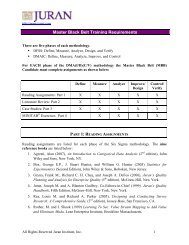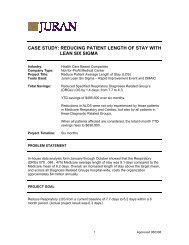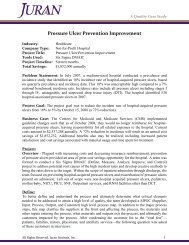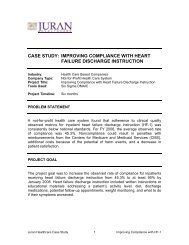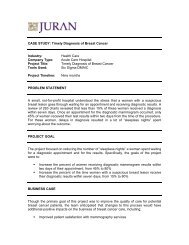Surgical Care Improvement Project (SCIP) - Juran Institute
Surgical Care Improvement Project (SCIP) - Juran Institute
Surgical Care Improvement Project (SCIP) - Juran Institute
Create successful ePaper yourself
Turn your PDF publications into a flip-book with our unique Google optimized e-Paper software.
A Quality Case Study<br />
<strong>Surgical</strong> <strong>Care</strong> <strong>Improvement</strong> <strong>Project</strong> (<strong>SCIP</strong>): Improve<br />
Compliance to the <strong>SCIP</strong> Bundle<br />
Industry: Healthcare<br />
Company Type: Five Hundred Bed Teaching Hospital<br />
Method Used: Lean Six Sigma<br />
<strong>Project</strong> Timeline: Three months<br />
Results: Improved <strong>SCIP</strong> composite score from 96.1% to 99.8%<br />
Problem Statement: Based on first quarter 2009 <strong>SCIP</strong> performance data, the <strong>SCIP</strong> composite<br />
score was 96.1%, which was below the target of 100%. Not meeting the target may result in<br />
potential post-operative infections for patients and loss of reimbursement for care provided.<br />
<strong>Project</strong> Goal: The goal of the project was to achieve 100% compliance in all existing and new<br />
<strong>SCIP</strong> bundle components.<br />
Business Case: Cost savings associated with the prevention of post-operative infections.<br />
Financial recognition for Leapfrog Hospital Rewards Program.<br />
<strong>Project</strong>:<br />
Overview - A team was formed to conduct a Lean Six Sigma DMAIC project to understand<br />
root causes of non-compliance to the <strong>SCIP</strong> bundle components. The project team consisted of<br />
individuals from multiple disciplines and departments responsible for surgical care.<br />
Define:<br />
In order to understand the needs of customers and stakeholders, team members gathered the<br />
voice of the customer (VOC) from outpatient surgery, O.R. staff, inpatient units, the pharmacy,<br />
and physicians through surveys, interviews, and observations. The resulting comments were<br />
grouped into key issues and translated into the following measurable critical-to-quality<br />
requirements (CTQs):<br />
1. 100% of <strong>SCIP</strong> patients identified successfully.<br />
2. 100% of surgical charts flagged.<br />
3. 100% of staff aware of <strong>SCIP</strong> components.<br />
4. 100% of pre-op orders written.<br />
5. Add <strong>SCIP</strong> to pre-op chart preparation form/OP checklist.<br />
6. Antibiotics available 100% of the time.<br />
7. Hand-offs to include <strong>SCIP</strong> components.<br />
8. Hot charts flagged for antibiotics discontinued.<br />
9. Increased use of standard protocol.<br />
All Rights Reserved, <strong>Juran</strong> <strong>Institute</strong>, Inc. 1
A Quality Case Study<br />
Measure:<br />
The main deliverable from the Measure Phase was the understanding of the current state<br />
condition. After walking the process and interviewing stakeholders, the project team created a<br />
current state process map. The process map provided a visual representation of how the<br />
individual departments satisfied the individual <strong>SCIP</strong> components. Swim lane diagrams identified<br />
the number of hand-offs and opportunities for defects and errors throughout the process. The<br />
project team created a data-collection plan, which described the questions to be answered and the<br />
data that needed to be collected in order to define baseline performance.<br />
Analyze:<br />
The main deliverable of the Analyze Phase was the identification of the vital few Xs or root<br />
causes that prohibit 100% compliance. The team used tools such as cause-effect diagrams and<br />
Pareto Analysis to understand where potential causes existed and analyzed the causes using 5<br />
WHY Analysis.<br />
The vital few Xs for improving <strong>SCIP</strong> compliance included:<br />
1. Lack of training and education<br />
2. Inadequate documentation<br />
3. Lack of standardized process and unclear expectations<br />
4. Variation in antibiotic management<br />
5. Surgeon variation<br />
6. Order sheet not used/antibiotic start time<br />
7. Lack of standardized orders for blood-glucose management<br />
Improve:<br />
The project team performed best practice research, brainstormed potential solutions to the vital<br />
few Xs and created a future state process map. Once the list of solutions were prioritized using<br />
tools such as an impact/cost matrix and risk assessment, the team created an implementation plan<br />
and communication/training plan. The implementation plan included long-term projects, rapid<br />
improvement events (RIE), and “just do it” projects. The improvements selected included the<br />
following:<br />
1. Electronically tag patients as <strong>SCIP</strong> based on the procedure code in the scheduling system.<br />
2. Use colored folders for charts and colored armbands.<br />
3. Draw a colored line over patient stickers.<br />
4. Place Bear Huggers on all patients in OR.<br />
5. Educate PACU nurses to make sure antibiotic start time is on post-op order sheets.<br />
6. Standardize post-op order sheet to include antibiotic and Lovenox ® order start time based<br />
on initial antibiotic administration time.<br />
7. Add specific data box requirements for antibiotic name, route, time, and <strong>SCIP</strong> on<br />
anesthesia record.<br />
All Rights Reserved, <strong>Juran</strong> <strong>Institute</strong>, Inc. 2
A Quality Case Study<br />
8. Create medical staff approved order sets for antibiotic selection.<br />
9. Revise perioperative records to reflect warming blankets.<br />
10. Investigate par levels and use of Diebold as back up for <strong>SCIP</strong> drugs. Deliver <strong>SCIP</strong> drugs<br />
directly to holding area.<br />
11. Include in <strong>SCIP</strong> binder process maps, standard worksheets, procedure list, <strong>SCIP</strong><br />
description and indicators, violation reporting and chain of command procedure and<br />
quick reference guide by case.<br />
12. Create training plan for all stakeholders on new process and <strong>SCIP</strong> components and<br />
introduce new accountability model.<br />
Control:<br />
The objective of the Control phase is to maintain process changes and monitor results. The<br />
project team decided to create a dual-purpose <strong>SCIP</strong> flow sheet that will travel with the patient as<br />
part of the chart. The flow sheet will collect real-time data on <strong>SCIP</strong> compliance, as well as serve<br />
as a checklist to ensure the patient does not move forward in the process until the <strong>SCIP</strong><br />
component is satisfied. As part of a control plan, the process owner will report-back status<br />
updates and control plan data to the project Champion and leadership team to ensure<br />
sustainability and long-term results.<br />
Results:<br />
The results obtained as of 4 th quarter discharges showed improvements in all of the <strong>SCIP</strong> bundle<br />
components except for antibiotic selection. Non-compliance in antibiotic selection was because of<br />
human error, and coaching was performed as part of the investigation and follow-up of each error as<br />
specified by the control plan. The results obtained as of 4 th quarter discharges were as follows:<br />
FOR MORE INFORMATION:<br />
For more information on how we can help your organization attain sustainable results, please<br />
contact us at 800.338.7726, or visit us on the web at www.juran.com.<br />
All Rights Reserved, <strong>Juran</strong> <strong>Institute</strong>, Inc. 3




